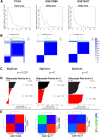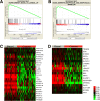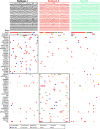Distinct esophageal adenocarcinoma molecular subtype has subtype-specific gene expression and mutation patterns
- PMID: 30355311
- PMCID: PMC6201634
- DOI: 10.1186/s12864-018-5165-0
Distinct esophageal adenocarcinoma molecular subtype has subtype-specific gene expression and mutation patterns
Abstract
Background: Esophageal carcinoma (EC), consists of two histological types, esophageal squamous carcinoma (ESCC) and esophageal adenocarcinoma (EAC). EAC accounted for 10% of EC for centuries; however, the prevalence of EAC has alarmingly risen 6 times and increased to about 50% of EC in recent 30 years in the western countries, while treatment options for EAC patients are still limited. Stratification of molecular subtypes by gene expression profiling methods had offered opportunities for targeted therapies. However, the molecular subtype in EAC has not been defined. Hence, Identification of EAC molecular subtypes is needed and will provide important insights for future new therapies.
Results: We performed meta-analysis of gene expression profiling data on three independent EAC cohorts and showed that there are two common molecular subtypes in EAC. Each of the two EAC molecular subtypes has subtype specific expression patterns and mutation signatures. Genes which were over-expressed in subtype I EACs rather than subtype II EAC cases, were enriched in biological processes including epithelial cell differentiation, keratinocyte differentiation, and KEGG pathways including basal cell carcinoma. TP53 and CDKN2A are significantly mutated in both EAC subtypes. 24 genes including SMAD4 were found to be only significantly mutated in subtype I EAC cases, while 30 genes including ARID1A are only significantly mutated in subtype II EACs.
Conclusion: Two EAC molecular subtypes were defined and validated. This finding may offer new opportunities for targeted therapies.
Keywords: Esophageal adenocarcinoma; Gene expression; Molecular subtype; Mutation; Therapy.
Conflict of interest statement
Ethics approval and consent to participate
Not applicable.
Consent for publication
Not applicable.
Competing interests
The authors declare that they have no competing interests.
Publisher’s Note
Springer Nature remains neutral with regard to jurisdictional claims in published maps and institutional affiliations.
Figures






Similar articles
-
Comprehensive Genomic Profiling of Advanced Esophageal Squamous Cell Carcinomas and Esophageal Adenocarcinomas Reveals Similarities and Differences.Oncologist. 2015 Oct;20(10):1132-9. doi: 10.1634/theoncologist.2015-0156. Epub 2015 Sep 2. Oncologist. 2015. PMID: 26336083 Free PMC article.
-
Identification of a lncRNA involved functional module for esophageal cancer subtypes.Mol Biosyst. 2016 Oct 18;12(11):3312-3323. doi: 10.1039/c6mb00101g. Mol Biosyst. 2016. PMID: 27539139
-
Comparative Molecular Analyses of Esophageal Squamous Cell Carcinoma, Esophageal Adenocarcinoma, and Gastric Adenocarcinoma.Oncologist. 2018 Nov;23(11):1319-1327. doi: 10.1634/theoncologist.2018-0143. Epub 2018 Jun 4. Oncologist. 2018. PMID: 29866946 Free PMC article.
-
Etiology, cancer stem cells and potential diagnostic biomarkers for esophageal cancer.Cancer Lett. 2019 Aug 28;458:21-28. doi: 10.1016/j.canlet.2019.05.018. Epub 2019 May 21. Cancer Lett. 2019. PMID: 31125642 Free PMC article. Review.
-
Genomic and Transcriptomic Characteristics of Esophageal Adenocarcinoma.Cancers (Basel). 2021 Aug 26;13(17):4300. doi: 10.3390/cancers13174300. Cancers (Basel). 2021. PMID: 34503107 Free PMC article. Review.
Cited by
-
Understanding Esophageal Cancer: The Challenges and Opportunities for the Next Decade.Front Oncol. 2020 Sep 10;10:1727. doi: 10.3389/fonc.2020.01727. eCollection 2020. Front Oncol. 2020. PMID: 33014854 Free PMC article. Review.
-
Clinical significance of molecular subtypes of gastrointestinal tract adenocarcinoma.World J Gastrointest Oncol. 2022 Mar 15;14(3):628-645. doi: 10.4251/wjgo.v14.i3.628. World J Gastrointest Oncol. 2022. PMID: 35321271 Free PMC article. Review.
-
Prognostic Value of Immune-Related Multi-IncRNA Signatures Associated With Tumor Microenvironment in Esophageal Cancer.Front Genet. 2021 Sep 30;12:722601. doi: 10.3389/fgene.2021.722601. eCollection 2021. Front Genet. 2021. PMID: 34659345 Free PMC article.
-
OSblca: A Web Server for Investigating Prognostic Biomarkers of Bladder Cancer Patients.Front Oncol. 2019 Jun 4;9:466. doi: 10.3389/fonc.2019.00466. eCollection 2019. Front Oncol. 2019. PMID: 31275847 Free PMC article.
-
The transcriptional landscape of endogenous retroelements delineates esophageal adenocarcinoma subtypes.NAR Cancer. 2023 Jul 26;5(3):zcad040. doi: 10.1093/narcan/zcad040. eCollection 2023 Sep. NAR Cancer. 2023. PMID: 37502711 Free PMC article.
References
MeSH terms
Substances
Supplementary concepts
Grants and funding
- 81602362/National Natural Science Foundation of China
- 162102310391/program for Science and Technology Development in Henan Province
- 2016GGJS-214/program for Young Key Teacher of Henan Province
- 18HASTIT048/program for Innovative Talents of Science and Technology in Henan Province
- 2015YBZR048/supporting grants of Henan University
LinkOut - more resources
Full Text Sources
Medical
Research Materials
Miscellaneous

